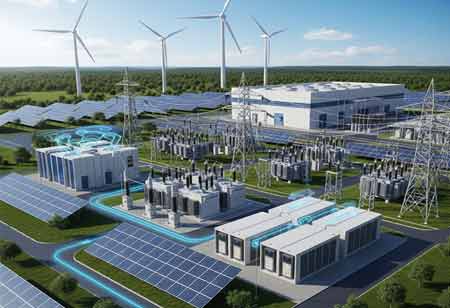Thank you for Subscribing to Energy Business Review Weekly Brief
Battery Storage & Grid Integration: Building Resilient Energy Systems in Canada
Canada is prioritizing battery storage to support its transition to renewable energy, aiming for a resilient grid and net-zero emissions by 2050 through the effective implementation of energy management solutions.

By
Energy Business Review | Wednesday, July 23, 2025
Stay ahead of the industry with exclusive feature stories on the top companies, expert insights and the latest news delivered straight to your inbox. Subscribe today.
Fremont, CA: Canada is increasingly recognizing the pivotal role of battery storage in building a resilient, sustainable, and decarbonized electricity grid. As the nation pushes towards ambitious net-zero targets by 2050, integrating intermittent renewable energy sources, such as wind and solar, becomes paramount, and battery storage emerges as a critical enabler.
The Imperative for Battery Storage in Canada
The country’s transition toward renewable energy is vital for achieving its climate targets, but it also introduces new operational challenges due to the intermittent nature of wind and solar generation. Without effective storage solutions, periods of high renewable output can result in curtailment—wasted energy that cannot be absorbed—while periods of low output often require a fallback on dispatchable, yet frequently carbon‑intensive, energy sources. Battery energy storage systems (BESS) offer a transformative solution to these challenges, enabling the grid to balance supply and demand.
The advantages of BESS for Canada’s grid are wide‑ranging. These systems facilitate the integration of renewable energy by storing surplus generation during off-peak periods and releasing it when demand rises or renewable output falls, thereby maximizing the use of clean energy. They bolster grid stability and reliability by providing rapid ancillary services such as frequency regulation and voltage support—capabilities that are increasingly critical as electrification of sectors like transportation and buildings accelerates overall demand. BESS also alleviates strain on existing infrastructure by managing peak loads, which can defer or even eliminate the need for costly transmission and distribution upgrades. They also enhance resilience by supplying reliable backup power during extreme weather events or unexpected outages. This benefit is particularly valuable for remote communities still reliant on diesel generation.
Current Landscape and Progress
The country’s robust innovation ecosystem is driving the development of next-generation storage solutions, including advanced lithium-ion chemistries, flow batteries, and other long-duration technologies that promise improved performance and cost efficiency. At the same time, increasing investments in domestic battery manufacturing—from critical mineral processing to cell production—are creating jobs, mitigating supply chain risks, and positioning Canada as a competitive force in the global battery market. Strategic partnerships among governments, utilities, technology providers, and Indigenous communities are proving vital in accelerating deployment and ensuring that the benefits of these advancements are shared equitably. The integration of battery storage with smart grid technologies and advanced analytics is paving the way for greater efficiency, enhanced reliability, and more active consumer participation in energy management.
Energy Storage Canada estimates that the country will require between 8,000 and 12,000 megawatts of energy storage capacity by 2035 to align with its net-zero goals. This significant projected growth underscores the transformative role of battery storage.
As Canada continues to modernize its grid, battery storage will be an increasingly integral part of the energy mix. By proactively addressing regulatory hurdles, fostering innovation, securing supply chains, and encouraging strategic partnerships, Canada can unlock the full potential of battery storage to build a truly resilient, sustainable, and secure energy future for all Canadians.






